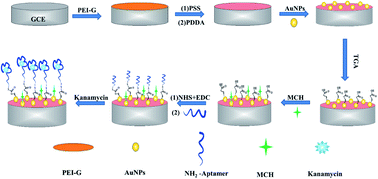A facile one-pot synthesis of polyethyleneimine functionalized graphene for the highly-sensitive and selective electrochemical impedance aptasensing of kanamycin in serum†
Abstract
A facile one-pot synthesis method for polyethyleneimine-functionalized graphene (PEI-G) was created by employing polyethyleneimine (PEI) as both the reductive and functionalized reagent to reduce and wrap exfoliated graphene oxide (EGO) to maintain the single layer status of graphene without aggregation. Based on the fine conductivity of PEI-G and high selectivity of the aptamer specially designed for kanamycin, a novel electrochemical impedance aptasensor for the highly-sensitive and selective detection of kanamycin in serum was fabricated using PEI-G as the electrode substrate to enhance the electrochemical signal and using the aptamer as a biological recognition unit to promote the selectivity. After the specific capture of kanamycin in the sample, the proposed aptasensor exhibited a fine line response for kanamycin within the range of 10 fM to 100 pM with a detection limit of 5.2 fM. Moreover, the proposed aptasensor also displayed a good reproducibility, stability and specificity, which was suitable for the trace kanamycin analyses in a real serum sample. Therefore, this proposed electrochemical impedance aptasensing strategy opens a new insight into potential applications in the clinical diagnostic use of kanamycin.



 Please wait while we load your content...
Please wait while we load your content...